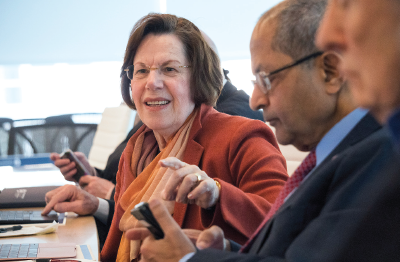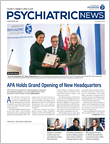A digital therapeutic relationship is emerging, and the nature of that relationship is up for grabs,” said John Torous, M.D., co-chair of the APA Ad Hoc Work Group on Access Through Innovation in Psychiatric Care.
Torous was speaking at the March meeting of the APA Board of Trustees about the way that digital technology—including live video conferencing, email, online chat, smartphone apps, and many other forms of technological innovation—may transform the relationship between physicians and patients, for better or worse.
Torous and work group chair John Santopietro, M.D., presented the Board with an ambitious report outlining recommendations in two key areas: emerging business models for delivering mental health care and digital medicine and health information technology. The Board of Trustees voted to accept the report and referred its recommendations to the Joint Reference Committee and the APA administration or a report in July on how to implement them.
The report of the work group, created by APA President Anita Everett, M.D., to address one of her top presidential priorities, was greeted with enthusiasm by APA Board members.
“Innovations in business models and technology are going to continue to evolve, and quickly, regardless of whether we like it,” Everett said. “The efforts of the work group and the report to the Board emphasize that these changes can be for good—by, for example, improving access to care and enhancing the efficiency and professional lives of psychiatrists—or for ill. What matters is whether we as a profession will be a part of this evolution and make our voice heard to protect the traditional values of psychiatry, especially the sanctity of the physician-patient relationship.”
Santopietro said the report and its recommendations are intended to inspire a sense of hope and a feeling of empowerment for APA members who may feel threatened by technological innovation. He emphasized that making wise use of technology and shaping it to reflect psychiatry’s core values can be a potent response to the problem of physician burnout—another priority of Everett’s presidential year.
He said some forms of innovation, such as the movement toward collaborative care, can expand the reach of psychiatry. “All of medicine is grounded in the doctor-patient relationship, psychiatry especially proudly so,” he said. “In some models the relationship may change from a 1-to-1 relationship to a 1-to-n”—a relationship with a population. Santopietro said the scope of the work group recommendations is meant to be aspirational while also being pragmatic and actionable—“an effort to capture lightning in a bottle,” he said, emphasizing the rapidly moving and unpredictable nature of innovation and technological advances.
The work group recommendations for the two areas—business models and digital medicine—each include a “strategic finding” followed by specific recommendations (six for business models and 14 for digital technology).
For business models the strategic finding is, in part, as follows: “Emerging models of care and systems financing that transition health care from fee-for-service to value-based payments that rely heavily on use of data … are promising but ultimately will require fundamental changes in psychiatric practice. …”
Among the strategic recommendations for APA to do regarding emerging business models are the following:
•
Take the lead setting the standards and expectations for measurement-based care.
•
Advocate for expanded reimbursement of the collaborative care model in state Medicaid programs and commercial insurance plans.
•
Maximize the use of PsychPRO (APA’s new mental health registry) to facilitate measurement-based care and quality measurement.
The strategic finding for digital medicine and health information technology is, in part, as follows: “The doctor-patient relationship is in flux, with care being redefined beyond the traditional office visit. ... Treatment modalities are also being redesigned via technology, including pharmacotherapeutics containing digital sensors, transcranial magnetic stimulation coaching via mobile apps, and others.”
Among the 14 strategic recommendations are the following:
•
APA must assume a leadership role in shaping the future of how digital psychiatry tools are used to augment care, strengthen the doctor-patient relationship, and improve access and quality of care.
•
APA should continue to expand its efforts to support smartphone app evaluation to enable psychiatrists and their patients to make safe and informed decisions around choosing an app.
•
APA should determine a process for curating a set of publicly available self-assessment tools on the APA website that are searchable using terms like “depression test” or “anxiety test.”
Torous and Santopietro emphasized the potential inherent in APA’s assuming leadership in the psychiatric “digital space”—setting the standards, for instance, for what defines a good smartphone app or a bad one, or even developing its own apps .“The arc of health care transformation will not necessarily bend toward the good unless people committed to psychiatry’s values and the soul of our clinical work help to shape that transformation,” Santopietro said. ■
Members may obtain a copy of the work group report by contacting Nathan Tatro at APA at
[email protected].


